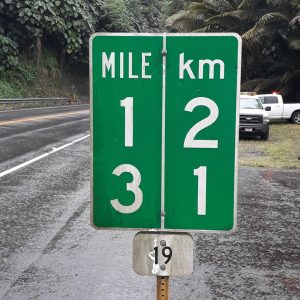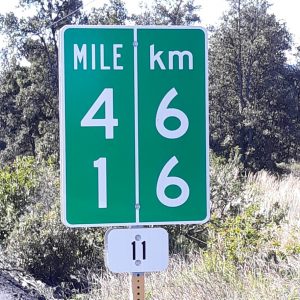Module 15: Converting Between Systems

You may use a calculator throughout this module.
Converting between the U.S. system and metric system is important in today’s global economy; like it or not, the metric system is infiltrating our lives.
The numbers in these conversion ratios are usually difficult to work with, so we will use a calculator whenever necessary and pay attention to rounding. If you discover other conversion ratios that aren’t provided here, write them down!
Converting Measurements of Length
You can use the conversion ratios in this table…
![]() in =
in = ![]() cm
cm
![]() ft
ft ![]() m
m
![]() yd
yd ![]() m
m
![]() mi
mi ![]() km
km
…or the equivalent conversion ratios in this table.
![]() cm
cm ![]() in
in
![]() m
m ![]() ft
ft
![]() m
m ![]() yd
yd
![]() km
km ![]() mi
mi
Okay, full disclosure: these conversion ratios aren’t exactly equivalent. For example, if we reverse the conversion ratio ![]() in =
in = ![]() cm[1], we discover that
cm[1], we discover that ![]() cm is actually
cm is actually ![]() inches. All of these conversion have been rounded to three significant figures, which means that we may get a slightly different result depending on which version of the conversion ratio we use. As long as we round our answer to three or fewer significant figures, though, we should be all right.
inches. All of these conversion have been rounded to three significant figures, which means that we may get a slightly different result depending on which version of the conversion ratio we use. As long as we round our answer to three or fewer significant figures, though, we should be all right.
Exercises
1. How many centimeters is ![]() inches?
inches?
2. Convert ![]() yards into meters.
yards into meters.
3. ![]() feet is equal to how many centimeters?
feet is equal to how many centimeters?
4. How many feet is ![]() meters?
meters?
5. ![]() meters is what length in yards?
meters is what length in yards?
6. Convert ![]() centimeters into inches.
centimeters into inches.
7. Is ![]() kilometers equivalent to
kilometers equivalent to ![]() miles? If not, what is the percent error?
miles? If not, what is the percent error?

8. Is ![]() kilometers equivalent to
kilometers equivalent to ![]() miles? If not, what is the percent error?
miles? If not, what is the percent error?

Converting Measurements of Weight or Mass
You can use the conversion ratios in this table…
![]() oz
oz ![]() g
g
![]() lb
lb ![]() kg
kg
…or the (almost) equivalent conversion ratios in this table.
![]() g
g ![]() oz
oz
![]() kg
kg ![]() lb
lb
You probably have noticed that some conversion problems involve multiplication but others involve division. This is based on which version of the conversion ratio you choose; any of these. If you prefer multiplying to dividing, see whether you can figure out a strategy for choosing your conversion ratio.
Exercises
9. Convert ![]() ounces into grams.
ounces into grams.
10. How many kilograms are equivalent to ![]() pounds?
pounds?
11. Convert ![]() grams to ounces.
grams to ounces.
12. Convert ![]() kilograms to pounds.
kilograms to pounds.
13. How many grams is a half pound of ground beef?
14. In around 2010, the National Collector’s Mint (not affiliated with the U.S. Mint) ran a TV commercial selling an imitation $ ![]() gold coin modeled after the U.S. “buffalo” nickel. The commercial made the following claims. This replica coin is coated in
gold coin modeled after the U.S. “buffalo” nickel. The commercial made the following claims. This replica coin is coated in ![]() milligrams of pure gold! And the price of gold keeps going up; gold is worth about $
milligrams of pure gold! And the price of gold keeps going up; gold is worth about $ ![]() per ounce! But you can order these fake coins for only $
per ounce! But you can order these fake coins for only $ ![]() apiece! What is the approximate dollar value of the gold in one of these coins?
apiece! What is the approximate dollar value of the gold in one of these coins?
15. In 2020, the National Collector’s Mint is still selling the imitation $ ![]() gold “buffalo” nickel for $
gold “buffalo” nickel for $ ![]() . This version of the coin is coated in
. This version of the coin is coated in ![]() milligrams of pure gold.[2] As of September 2, 2020, the price of gold is $
milligrams of pure gold.[2] As of September 2, 2020, the price of gold is $ ![]() per ounce.[3] What is the approximate dollar value of the gold in one of these coins?
per ounce.[3] What is the approximate dollar value of the gold in one of these coins?
Converting Measurements of Volume or Capacity
You can use the conversion ratios in this table…
![]() fl oz
fl oz ![]() mL
mL
![]() qt
qt ![]() L
L
![]() gal
gal ![]() L
L
…or the (almost) equivalent conversion ratios in this table. This table includes one extra entry.
![]() mL
mL ![]() fl oz
fl oz
![]() L
L ![]() qt
qt
![]() L
L ![]() gal
gal
![]() L
L ![]() fl oz
fl oz
Exercises
16. A toilet uses ![]() gallons of water per flush. How many liters is this?
gallons of water per flush. How many liters is this?
17. How many milliliters of drink are in a ![]() -ounce can?
-ounce can?
18. How many fluid ounces are in a ![]() milliliter mini-sized bottle of alcohol?
milliliter mini-sized bottle of alcohol?
19. What part of a gallon is in a ![]() -liter bottle of soda pop?
-liter bottle of soda pop?
Converting Measurements: Extensions
Let’s finish up with some rates that require conversions.
Exercises
Maxine is driving across Canada. Her car has a ![]() -gallon gas tank and gets an average of
-gallon gas tank and gets an average of ![]() miles per gallon.
miles per gallon.
20. Approximately how many kilometers—actually, the Canadian spelling is kilometres. Approximately how many kilometres can she travel on a full tank of gas?
21. Of course, Canada measures gas in liters. Actually, litres. Convert Maxine’s mileage rate, ![]() miles per gallon, to kilometres per litre.
miles per gallon, to kilometres per litre.
- An inch is defined to be exactly
 cm, if you were curious. ↵
cm, if you were curious. ↵ - https://ncmint.com/2020-buffalo-tribute-proof/ ↵
- https://markets.businessinsider.com/commodities/gold-price ↵

